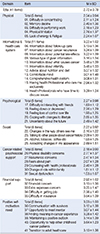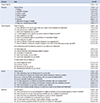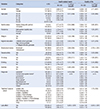Abstract
Purpose
The purpose of this study was to identify the health-related needs and quality of life in childhood cancer survivors and to identify the relationship between health-related needs and quality of life.
Methods
Data were collected from April 11 to May 30, 2014. The participants aged 18~35 years diagnosed with a childhood cancer had completed actual treatment (surgery, chemotherapy, or radiation therapy) at least two years earlier. They were randomly selected from among childhood cancer survivors under follow-up management after cancer treatment at three general hospitals in Korea. Descriptive statistics, t-tests, one-way ANOVA, the post-hoc Scheffé test, and Pearson's correlation coefficients were used to analyze the data.
Results
Among the 371 participants, 214 (57.7%) were male and the mean age was 22.5 years. The mean score for health-related needs was 2.72 out of 5. Positive self-motivation need had the highest mean score of domain. The mean score for quality of life was 5.92 out of 10. Health-related needs and quality of life were negatively correlated (r= - .70, p<.001).
Figures and Tables
Table 1
Health-related Needs (N=371)

Table 2
Quality of Life (N=371)

Table 3
Difference in Health-related Needs and Quality of Life by Characteristics of Participants (N=371)

Table 4
Correlation between Health-related Needs and Quality of Life

References
1. National Cancer Information Center. Cancer Facts and Figures 2011. Accessed Jan 25, 2015. http://www.cancer.go.kr.
2. Ghim TT. Time to establish multidisciplinary childhood cancer survivorship programs in Korea. Korean J Hematol. 2010; 45(2):84–87.

4. Prouty D, Ward-Smith P, Hutto CJ. The lived experience of adult survivors of childhood cancer. J Pediatr Oncol Nurs. 2006; 23(3):143–151.

5. Brown RT, Madan-Swain A, Lambert R. Posttraumatic stress symptoms in adolescent survivors of childhood cancer and their mothers. J Trauma Stress. 2003; 16(4):309–318.

6. Rourke MT, Hobbie WL, Schwartz L, Kazak AE. Posttraumatic stress disorder (PTSD) in young adult survivors of childhood cancer. Pediatr Blood Cancer. 2007; 49(2):177–182.

7. Kim MA, Yi J. Psychological distress in adolescent and young adult survivors of childhood cancer in Korea. J Pediatr Oncol Nurs. 2013; 30(2):99–108.

8. Mertens AC, Liu Q, Neglia JP, Wasilewski K, Leisenring W, Armstrong GT, et al. Cause-specific late mortality among 5-year survivors of childhood cancer: the Childhood Cancer Survivor Study. J Natl Cancer Inst. 2008; 100(19):1368–1379.

9. Reulen RC, Winter DL, Frobisher C, Lancashire ER, Stiller CA, Jenney ME, et al. Long-term cause-specific mortality among survivors of childhood cancer. JAMA. 2010; 304(2):172–179.

10. Rowland JH, Bellizzi KM. Cancer survivors and survivorship research: a reflection on today's successes and tomorrow's challenges. Hematol Oncol Clin North Am. 2008; 22(2):181–200.

11. Lim YT, Bae SN. Growth pattern in children of acute lymphoblastic leukemia during and after therapy. Korean J Pediatr Hematol Oncol. 2000; 7(1):50–56.
12. Jang PS, Shin HY, Ahn HS. Sexual development and reproductive function in male adults treated for childhood acute lymphoblastic leukemia or malignant lymphoma. Korean J Pediatr Hematol Oncol. 2002; 9(1):21–29.
13. Lee YJ, Kim YH, Hah JO. Prevalence of obesity and cardiovascular risk factors in survivors of childhood acute lymphoblastic leukemia. Korean J Pediatr Hematol Oncol. 2003; 10(2):198–205.
14. Han JW, Kwon SY, Won SC, Shin YJ, Ko JH, Lyu CJ. Comprehensive clinical follow-up of late effects in childhood cancer survivors shows the need for early and well-timed intervention. Ann Oncol. 2009; 20(7):1170–1177.

15. You MA. Content analysis on psychosocial adjustment of adolescent survivors of leukemia. J Korean Acad Child Health Nurs. 2006; 12(3):304–313.
16. Kim Y, Cha H, Kim C, Park Y, Kim H, Seo J, et al. Child cancer survivors' quality of life based on their parents' support and past history. J Korean Acad Psychiatr Ment Health Nurs. 2008; 17(1):85–96.
17. Kwon HJ, Kim YJ, Cha HG. Relationship of self-esteem and social support to depression in child cancer survivors. J Korean Acad Child Health Nurs. 2009; 15(2):219–227.

18. Park HJ, Nam BH, Yun YH, Yang WJ, Kang HJ, Shin HY, et al. Establishment of Korean childhood cancer survivor cohort and long-term follow-up system. Clin Pediatr Hematol Oncol. 2007; 14(1):1–42.
19. Kim MA, Yi Jh. Childhood Cancer Survivor's Services Needs for the Better Quality of Life. J Korean Acad Child Health Nurs. 2012; 18(1):19.

21. Becknell EP, Smith DM. System of nursing practice: a clinical nursing assessment tool. Philadelphia: FA Davis Company;1975.
22. Lim SJ. Development of Health-related Need Scale for childhood cancer survivors [dissertation]. Seoul: Yonsei Univ.;2014.
23. Hudson MM, Mertens AC, Yasui Y, Hobbie W, Chen H, Gurney JG, et al. Health status of adult long-term survivors of childhood cancer: a report from the childhood cancer survivor study. JAMA. 2003; 290(12):1583–1592.

24. Yoo SW, Shin H, Yeo MS, Jun H, Jang CH, Kim SH, et al. Prevalence of late effects by designed health promotion program in long-term survivors of childhood cancer. Clin Pediatr Hematol Oncol. 2012; 19(1):31–39.
25. Han JW, Kim HS, Kim BS, Kwon SY, Shin YJ, Kim SH, et al. Increasing and worsening late effects in childhood cancer survivors during follow-up. J Korean Med Sci. 2013; 28(5):755–762.

26. Clarke SA, Skinner R, Guest J, Darbyshire P, Cooper J, Vora A, et al. Clinical outcomes and health-related quality of life (HRQOL) following haemopoietic stem cell transplantation (HSCT) for paediatric leukaemia. Child Care Health Dev. 2011; 37(4):571–580.

27. Nagel K, Eves M, Waterhouse L, Alyman C, Posgate S, Jamieson J, et al. The development of an off-therapy needs questionnaire and protocol for survivors of childhood cancer. J Pediatr Oncol Nurs. 2002; 19(6):229–233.

28. Earle EA, Davies H, Greenfield D, Ross R, Eiser C. Follow-up care for childhood cancer survivors: a focus group analysis. Eur J Cancer. 2005; 41(18):2882–2886.





 PDF
PDF ePub
ePub Citation
Citation Print
Print


 XML Download
XML Download